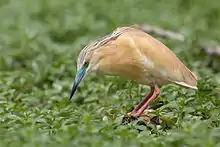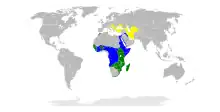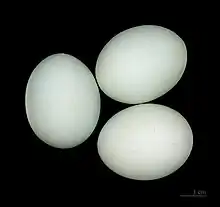Squacco heron
The squacco heron (Ardeola ralloides) is a small heron, 44–47 cm (17+1⁄2–18+1⁄2 in) long, of which the body is 20–23 cm (8–9 in), with 80–92 cm (31+1⁄2–36 in) wingspan.[2] It is of Old World origins, breeding in southern Europe and the Greater Middle East.
| Squacco heron | |
|---|---|
 | |
| Ariège, France | |
| Scientific classification | |
| Domain: | Eukaryota |
| Kingdom: | Animalia |
| Phylum: | Chordata |
| Clade: | Dinosauria |
| Class: | Aves |
| Order: | Pelecaniformes |
| Family: | Ardeidae |
| Genus: | Ardeola |
| Species: | A. ralloides |
| Binomial name | |
| Ardeola ralloides (Scopoli, 1769) | |
 | |
| Range of A. ralloides Breeding range Year-round range Wintering range | |
Behaviour
The squacco heron is a migrant, wintering in Africa. It is rare north of its breeding range. The species has been recorded in Fernando de Noronha islands, and more rarely in mainland South America, as a vagrant. This is a stocky species with a short neck, short thick bill and buff-brown back. In summer, adults have long neck feathers. Its appearance is transformed in flight, when it looks very white due to the colour of the wings.
The squacco heron's breeding habitat is marshy wetlands in warm countries. The birds nest in small colonies, often with other wading birds, usually on platforms of sticks in trees or shrubs. Three to four eggs are laid. They feed on fish, frogs and insects.
_in_flight.jpg.webp) Flying in Cyprus
Flying in Cyprus_breeding_colour_composite.jpg.webp) Composite showing changes during breeding
Composite showing changes during breeding
Etymology
The English common name squacco comes via Francis Willughby (c. 1672) quoting a local Italian name sguacco. The current spelling comes from John Hill in 1752.[3]
The scientific name comes from Latin ardeola, a small heron (ardea), and ralloides, Latin rallus, a rail and Greek -oides, "resembling".[4]
Breeding
The Squacco Heron uses freshwater localities throughout Europe and the Middle East as breeding grounds to later migrate south to the Sub-Saharan African region. Non-breeding Squacco Herons share similar traits with other heron species like the Indian Pond Heron and Malagasy Pond Heron which show tawny color plumage, lighter streaking, smaller bill, and narrower wing tips.[5]

References
- BirdLife International (2018). "Ardeola ralloides". IUCN Red List of Threatened Species. 2018: e.T22697123A131940696. doi:10.2305/IUCN.UK.2018-2.RLTS.T22697123A131940696.en. Retrieved 13 November 2021.
- Snow, David William; Perrins, Christopher, eds. (1997). The Birds of the Western Palearctic [Abridged]. OUP. ISBN 0-19-854099-X.
- Lockwood, W.B. (1993). The Oxford Dictionary of British Bird Names. OUP. ISBN 978-0-19-866196-2.
- Jobling, James A (2010). The Helm Dictionary of Scientific Bird Names. London: Christopher Helm. pp. 54, 330. ISBN 978-1-4081-2501-4.
- "HeronConservation » Squacco Heron". Retrieved 2022-03-19.
External links
- Blasco-Zumeta, Javier; Heinze, Gerd-Michael. "Squacco heron" (PDF). Identification Atlas of Aragon's Birds.
- Squacco Heron - The Atlas of Southern African Birds
- Ardeola ralloides in Field Guide: Birds of the World on Flickr
- "Ardeola ralloides". Avibase.
- Squacco Heron at oiseaux.net
- BirdLife species factsheet for Ardeola ralloides
- "Squacco heron media". Internet Bird Collection.
- Squacco heron photo gallery at VIREO (Drexel University)
- Audio recordings of Squacco heron on Xeno-canto.
